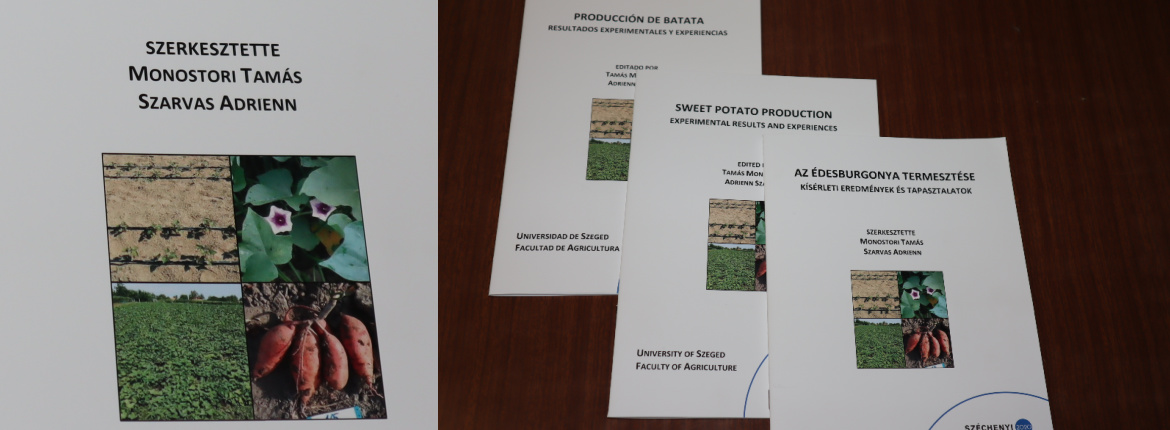Event Calendar 
-
February 10. 00:01 - May 24. 23:59
-
May 12. 00:01 - 16. 23:59
-
May 12. 00:01 - July 11. 23:59
-
May 12. 00:01 - 25. 23:59
-
May 12. 09:00 - 16. 13:30

The booklet is published in three languages; Hungarian, English and Spanish and it was edited by Tamás MONOSTORI Ph.D. and Adrienn SZARVAS Ph.D.
The publication was prepared in the framework of the project “Development of site- and cultivar-specific cultivation technologies as well as the production of pathogen-free propagating material of sweet potato” supported by the program “Establishing innovation operational groups and supporting the investment necessary for the implementation of the innovate project - VP3-16.1.1-4.1.5-4.2.1-4.2.2-8.1.1-8.2.1-8.3.1-8.5.1-8.5.2-8.6.1-17”.
Among the traditional aspects discussed during plant cultivation technologies, the research group achieved new results primarily with four repetitions in randomized block design experiments dealing with propagating material production, planting and nutrient replenishment but in addition to these they also gained experience in climate- and soil demands, plant protection, harvesting and in other aspects.
During the research, attention was paid to the increasing problems in plant protection, because with the increase of the production area, damages by more and more pathogens and pests can be observed on the sweet potato.
They examined the raison de’etre of alternative nutrient supply methods, such as bacterial fertilizers, in connection with which they concluded that they can be effectively used to improve crop safety and yield.
Among other things, the cause of a recurring problem, the formation of "pencil roots", was investigated. In this case, the storage root does not develop, and cannot be sold as a crop, and only tufted roots system covered with capillary roots develop. The formation of tubers is adversely affected by extreme drought, insufficient irrigation water and irregular water supply. Positive effects, however, can be obtained by using variety-specific planting techniques. A denser spacing, different from the generally recommended spacing, resulted in higher yields. Although more propagating material was needed, the profit from the higher yields amply covered the costs.
Machine harvesting is also effective in the case of sweet potatoes. Defects and injuries on the fragile skin can be easily cured by post-harvest heat treatment, so the plant can be preserved for a longer period of time. Another positive effect of the heat treatment is that the well-known, sweet taste of the sweet potato develops as a result.
From a commercial and consumer point of view, the fact that sweet potatoes are expensive in Hungary is a problem. As the crops, grown in Hungary, does not coves consumer needs, it is only available seasonally until spring and during the rest of the year we can only get sweet potatoes as imported goods or in processed form. This publication was created with the aim that the new cultivation aspects - supported by experiments - contribute to the improvement of cultivation technology and may increase the desire to produce the crop.
The production of sweet potato propagating material in Hungary is currently not under strict official control, which is well established for our traditional economic crops, warned Tamás Monostori Ph.D. At present, seven sweet potato viruses are infecting our country, which in the absence of proper control, could lead to a shortage of domestic propagating material for a vegetatively propagated plant like sweet potato. Serious growers are looking for propagation material of guaranteed quality, so there is a risk that domestic varieties will be supplanted by guaranteed virus-free propagating material of international varieties imported from abroad.
In addition to the Faculty of Agriculture of the University of Szeged, two research sites of the Hungarian University of Agriculture and Life Sciences, three farmers, two experts and a total of about 25 people participated in the research.